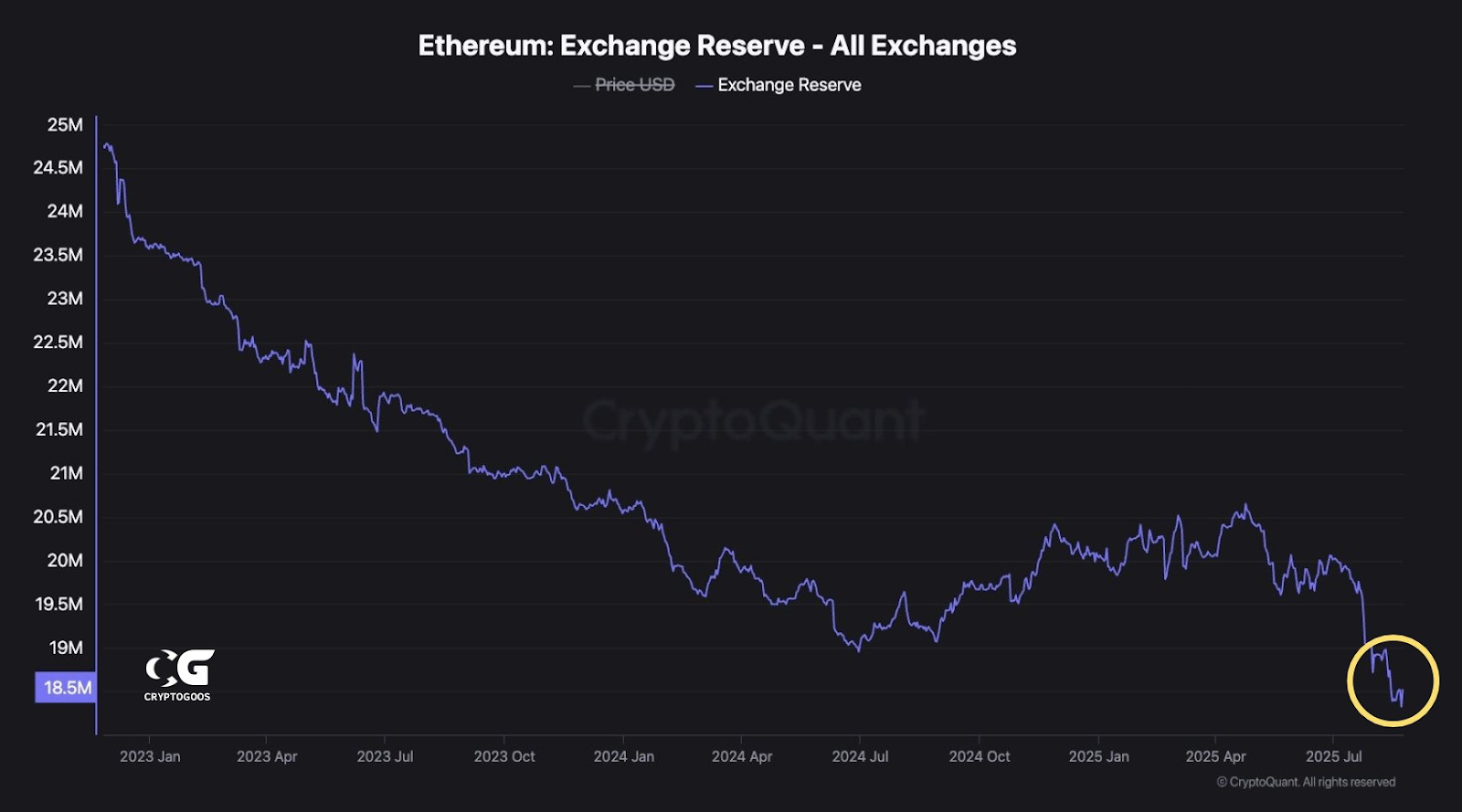Ethereum whale profits surged to roughly $102 million as long-term accumulation and large deposits coincide with shrinking Ethereum exchange reserves, while continued institutional Ethereum buying tightens available supply and signals stronger demand.
-
Whale realized profit: ~$102M from a nine‑year accumulation.
-
Exchange reserves fell from 24.5M ETH to 18.5M ETH, indicating major outflows to staking and cold storage.
-
Institutions (Tom Lee via Arkham, Bitmine) continue buying, reinforcing long‑term demand with $45M+ reported purchases.
Ethereum whale profits highlight shrinking exchange reserves and stronger demand; read the full analysis and on‑chain data insight from COINOTAG.
What caused the $102M Ethereum whale profit and why it matters?
Ethereum whale profits stem from a nine‑year accumulation that turned a $258K position into an estimated $102M realized gain, showing how patient holdings and reduced exchange liquidity can amplify returns. This movement matters because it tightens circulating supply and signals durable demand.
How are institutional Ethereum buying patterns affecting supply?
Institutional Ethereum buying — documented by Arkham and other on‑chain trackers — shows sizable purchases, including a reported $45M buy associated with Tom Lee and continued accumulation by Bitmine. These flows remove ETH from liquid markets and strengthen the narrative of institutional confidence, adding sustained demand pressure.
Ethereum whale profits $102M as reserves shrink and institutions buy more, signaling growing demand and reduced supply in the market.
- A whale turned $258K into $102M with Ethereum and still holds millions, showing the power of patience in crypto investing.
- Institutions like Tom Lee and Bitmine keep buying Ethereum heavily, proving growing confidence in its long-term strength and value.
- Ethereum reserves on exchanges fell from 24.5M to 18.5M, signaling shrinking supply and rising demand across wallets and staking.
On‑chain data shows a notable whale deposited 1,400 ETH (~$6.63M) into Kraken after having accumulated nearly 24,959 ETH for approximately $258,000 nine years ago. The investor realized an estimated profit above $102 million, illustrating how long‑term accumulation strategies can reshape market flows and liquidity dynamics.
The whale still controls roughly 13,477 ETH (valued near $64.52M). Of that, 877 ETH resides in a secondary wallet and 140 ETH is actively staked with Everstake Pool. These allocations show a mix of custodial deposits, private storage and staking as primary uses for large holdings.
Why are exchange reserves declining and what does it imply?
Exchange outflows are the single clearest indicator of shrinking sell‑side liquidity. Data from CryptoGoos shows exchange reserves fell from 24.5 million ETH in January 2023 to 18.5 million ETH by July 2025. This decline reduces available trading supply and may increase price sensitivity to large buy orders.

Source: CryptoGoos
Most outflows recorded since mid‑2023 moved into private storage and staking solutions, reducing exchange‑accessible ETH. Reduced exchange reserves typically correlate with lower circulating supply and can amplify the market impact of concentrated buys or sells.
How can traders and analysts track similar whale movements?
Track on‑chain analytics platforms and watch large transfers to exchange addresses, staking contracts and custodial wallets. Key signals include sustained accumulations, repeated deposits to a single exchange, and staking inflows that remove ETH from trading pools.
Frequently Asked Questions
How much did the whale originally invest and what is the current stake?
The whale initially invested about $258,000 to accumulate roughly 24,959 ETH. After realizing approximately $102M in profits, the whale still controls about 13,477 ETH across wallets and staking positions.
What does a drop from 24.5M to 18.5M ETH on exchanges mean for traders?
A decline of that magnitude reduces immediate sell liquidity. Traders should expect thinner order books and higher price sensitivity to large market orders, while long‑term holders may face reduced slippage on accumulation events.
Key Takeaways
- Concentration of gains: Long‑term accumulation can produce outsized realized profits, as shown by the ~$102M whale gain.
- Supply contraction: Exchange reserves falling to 18.5M ETH signal less tradable supply and more ETH locked in staking or cold storage.
- Institutional demand: Continued institutional Ethereum buying reinforces scarcity narratives and supports longer‑term demand.
Conclusion
COINOTAG analysis shows that the combination of significant whale profits, persistent institutional Ethereum buying and a steady decline in exchange reserves has tightened available supply and bolstered demand signals. Market participants should monitor on‑chain flows and exchange reserves to assess future price sensitivity and liquidity conditions.
